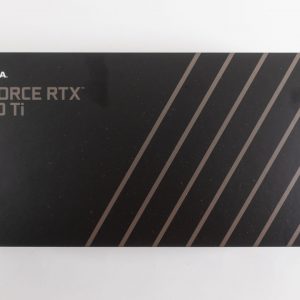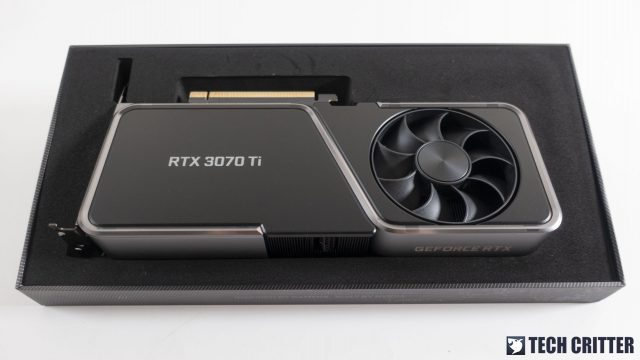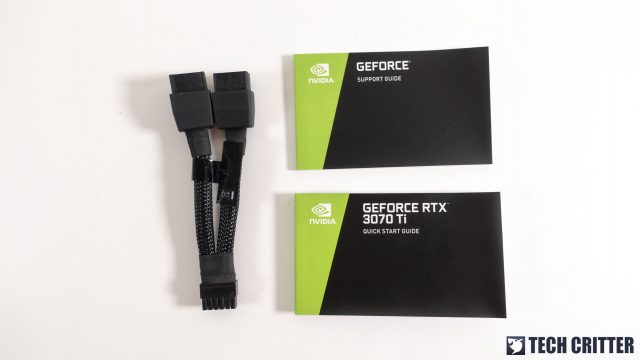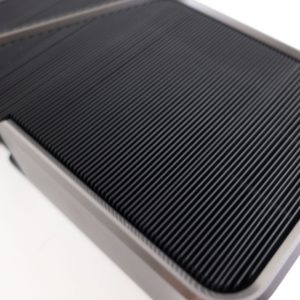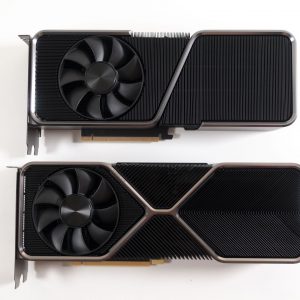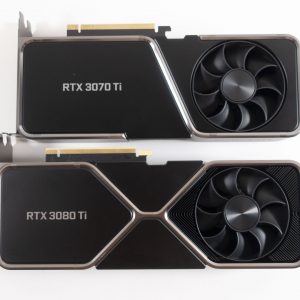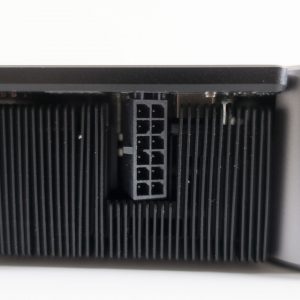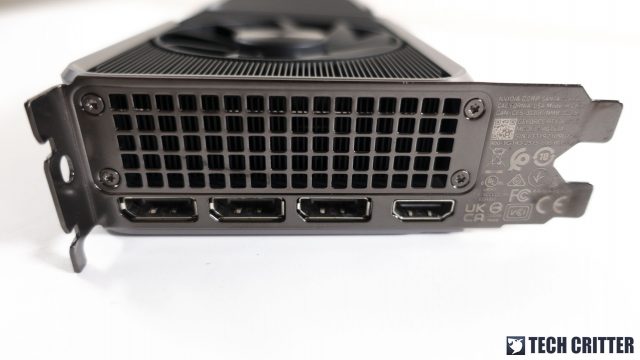NVIDIA recently announced two new addition to its RTX 30 series graphics card family and after seeing what the RTX 3080 Ti is capable of, it’s time for us to shift the attention to the RTX 3070 Ti this time. We managed to get our hands on the RTX 3070 Ti Founders Edition for this review, which is great for checking out what kind of base performance we can expect from it and serving as a reference for other upcoming custom designs from the other NVIDIA board partners.
Specifications
| GPU | GeForce RTX 3070 | GeForce RTX 3070 Ti | GeForce RTX 3080 |
| CUDA Cores | 5888 | 6144 | 8704 |
| Tensor Cores | 184 | 192 | 272 |
| RT Cores | 46 | 48 | 68 |
| GPU Boost Clock | 1.72GHz | 1.77GHz | 1.71GHz |
| Memory Data Rate | 14 Gbps | 19 Gbps | 19 Gbps |
| Total Video Memory Size | 8GB GDDR6 | 8GB GDDR6X | 10GB GDDR6X |
| Memory Interface | 256-bit | 256-bit | 320-bit |
| Memory Bandwidth | 448.0 GB/s | 608.3 GB/s | 760.3 GB/s |
| TDP | 220W | 290W | 320W |
| Recommended PSU | 650W | 750W | 750W |
| Power Connectors | 1 x 12-Pin | 1 x 12-Pin | 1 x 12-Pin |
Unboxing
Compared to the previously released RTX 30 series Founders Edition cards, the RTX 3070 Ti Founders Edition comes with a more compact box this time but the overall build is still solid as ever. The same compact box can be seen on the RTX 3080 Ti Founders Edition, so I’m guessing that NVIDIA will be going in this direction for its Founders Edition cards as of now?
Under the hood, you’ll find the RTX 3070 Ti Founders Edition sits tightly in the middle of a piece of thick foam to protect it against damage during shipping. We’ve seen numerous rough handling from the courier side throughout the years and this design will definitely keep the card for most of the time.
The accessories that come with the RTX 3070 Ti Founders Edition includes a dual 8-pin to 12-pin adapter, the usual support guide, and quick start guide.
The GeForce RTX 3070 Ti Founders Edition
Design-wise, while the RTX 3070 Ti Founders Edition looks a little similar to the RTX 3070 Founders Edition at first glance, the actual cooling design is pretty much the same as the RTX 3080 Founders Edition and above.
The cooler has one axial fan on each side, both are meant to cool the heatsink but the rear fan also helps to channel the heat to the top part of your PC case so it can be removed from your system via the rear cooling fan. A similar design can be seen across the custom design on the partner’s cards.
We have a side-by-side comparison here for those of you who are curious about the size and the design, just in case. While the cooling design is really similar on both cards, the RTX 3070 Ti Founders Edition is slightly shorter than the RTX 3080 Ti Founders Edition.
While the dual-slot compact design and sturdy metal frame build is a strong point for the RTX 30 series Founders Edition cards, the PCIe power connector and its placement is probably the least favorable for most users out there. Unless you’re using a newer power supply that comes with a 12-pin PCIe power cable, you’ll have to stick to the included adapter which is a pain to deal with when it comes to cable management.
The display output options are the commonly seen single HDMI and three DisplayPort but I do appreciate the large grill at the back for extra ventilation.
Test System Setup
For our games benchmark test, we’ve selected a number of AAA titles to run at its highest possible settings using the following setup under an ambient temperature of 31°C:
| CPU | Intel Core i9-10900K |
| Motherboard | ASUS ROG Maximus XII Apex |
| Memory | TEAMGROUP T-FORCE XTREEM ARGB DDR4 @3600MHz |
| Graphics Card | NVIDIA GeForce RTX 3070 Ti Founders Edition |
| Power Supply | Enermax MaxTytan 1250W / Cooler Master V1200 Platinum |
| Primary Storage | Kingston NV1 PCIe NVMe SSD 1TB |
| Secondary Storage | WD Black 6TB |
| CPU Cooler | Cooler MasterLiquid Master ML360R RGB |
| Chassis | Streacom Open Benchtable BC1 |
| Operating System | Windows 10 64bit |
Games Benchmark (DX12)
Starting off with the raster performance, it’s just as what NVIDIA claims, a buffed-up RTX 3070 with more CUDA cores, RT and Tensor Cores, as well as GDDR6X memory. Despite that upgrade, there’s still a noticeable wide performance gap between the RTX 3070 Ti and RTX 3080, unlike the RTX 3080 Ti that performs pretty much on par with an RTX 3090 as we’ve observed.
Even though the RTX 3070 Ti struggles quite a bit on 4K resolution, we can see that it’s still capable of 4K gaming if you’re willing to reduce the graphics settings in exchange for better framerates. As for those who prefer to stay on the highest graphics settings for the best visual experience, 1440P is pretty much the highest recommend to go for.
Games Benchmark (DXR)
Moving on to the ray tracing performance, 1080P is pretty much the recommended resolution if you wish to go with the highest ray-traced effects and DLSS quality mode. If you’re pushing for 1440P and don’t really want to go all the way down to the lowest settings, lowering the ray-traced effect settings or switching to DLSS balanced mode will definitely help with the overall performance.
What about RTX ON 4K gaming with the RTX 3070 Ti? Well, you might want to leave that to the higher-end models like the RTX 3080 or above. Even if you’re willing to go with the lowest ray-traced effect and DLSS ultra-performance mode for games like Cyberpunk 2077, the overall visual experience will be very limited and you might not even notice the ray-traced effect at all.
Thermals & Power Draw
We’ve monitored the thermal performance of the RTX 3070 Ti on gaming and FurMark stress test and turns out that both tests share an identical load temperature of 82ºC. You can probably see an even lower temperature on the partner’s cards but at least this will serve as a good base reference to see if the custom card has a bad cooler design.
The power draw totally depends on what the card is used for, as we’ve observed a range between 258W-283W throughout our test with selected AAA titles and FurMark stress test. This however, is a bit disappointing because the performance gain isn’t that significant compared to the RTX 3070 which only draws 220W on load.
Final Thoughts
If we look at the performance it can deliver, all I can say is don’t get your hopes too high on this because it’s definitely not like what we’ve observed on the RTX 3080 Ti, which is essentially an RTX 3090 with half of the VRAM. The RTX 3070 Ti might be a buffed-up RTX 3070 as NVIDIA claims, but the 5-10% improvement in performance is somewhat disappointing for a Ti card. Now, don’t get me wrong here, the RTX 3070 Ti is still a very powerful graphics card that can easily handle plenty of new AAA titles at 1440P, but I’m expecting the kind of performance increase like what we’ve seen on the GTX 1070 Ti back then.
Will I recommend this card? Well, I’d say the $599 price tag is definitely a bit too much for the 5-10% performance increase from an RTX 3070 that cost $499 at launch. And since it’s not going to be a worthy upgrade for RTX 3070 users, users coming from GTX 10 series, lower-mid tier RTX 20 series might find the RTX 3070 Ti a reasonable upgrade. Though seeing the performance gap we’ve observed from our test, I’d still recommend the RTX 3080 if one can stretch their budget a little further, which offers a better value in terms of price and performance.
Pros
- Solid build quality
- Runs very quiet even during load
- Runs slightly faster than the RTX 3070
Cons
- Not really a great value for money
- Draw more power but minimal performance gain over the RTX 3070


